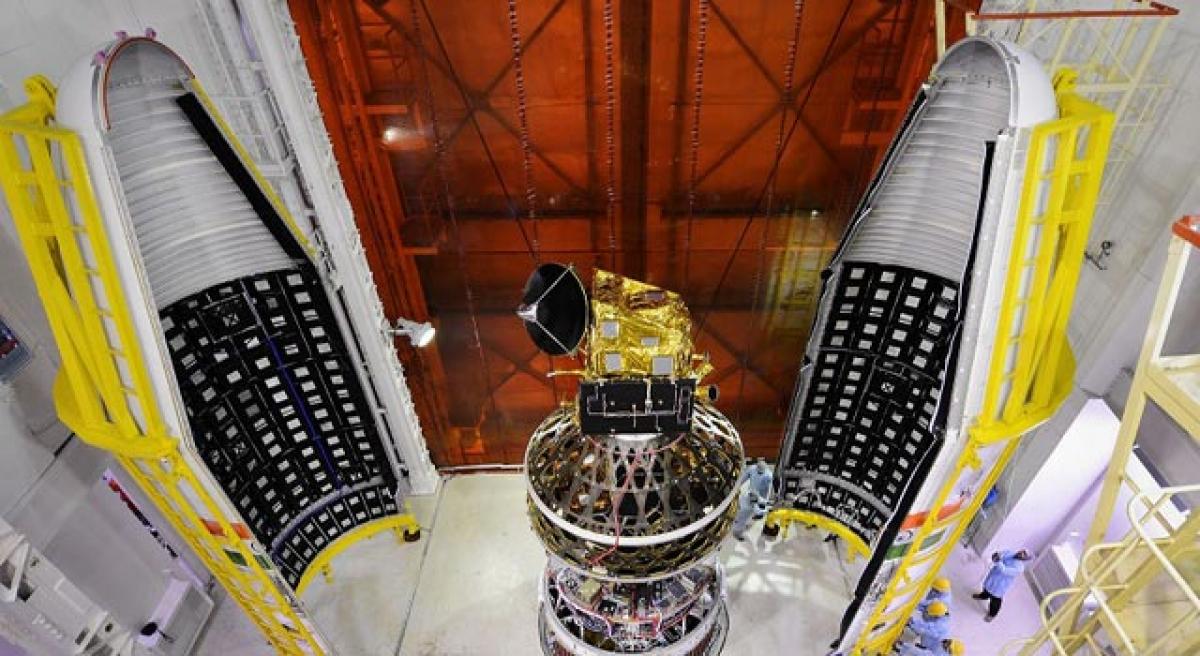Live
- First Star Outside Milky Way Captured: WOH G64 is 2,000 Times Larger Than the Sun
- Sikkim govt to constitute state Niti Ayog: CM Tamang
- CBI books Rajasthan narcotics inspector for Rs 3 lakh bribe
- Rajasthan bypolls: A tough contest between BJP and Congress
- Albania joins SEPA, paving way for EU integration
- Japanese government approves 250-billion USD economic package to ease price pain
- Six pharma companies to set up their units in Telangana
- The Unstable Events of a 17-Wicket Day in Perth: India vs Australia
- Dutch FM's Israel trip cancelled after Netanyahu's arrest warrant
- UK to increase energy price cap by 1.2 per cent
Just In

In its thirty seventh flight (PSLV-C35), ISRO\'s Polar Satellite Launch Vehicle successfully launched the 371 kg SCATSAT-1 Satellite along with seven co-passenger satellites on September 26 morning from Satish Dhawan Space Centre SHAR, Sriharikota.
In its thirty seventh flight (PSLV-C35), ISRO's Polar Satellite Launch Vehicle successfully launched the 371 kg SCATSAT-1 Satellite along with seven co-passenger satellites on September 26 morning from Satish Dhawan Space Centre SHAR, Sriharikota. This is the thirty sixth consecutively successful mission of PSLV. The total weight of all the eight satellites carried on-board PSLV-C35 was 675 kg. PSLV-C35 is the first PSLV mission to launch satellites carried onboard into two different orbits.
This PSLV mission was the longest of the PSLV missions conducted till date. SCATSAT-1 is a continuity mission for Oceansat-2 Scatterometer to provide wind vector data products for weather forecasting, cyclone detection and tracking services to the users. The satellite carries Ku-band Scatterometer similar to the one flown onboard Oceansat-2.
The spacecraft is built around standard IMS-2 Bus and the mass of the spacecraft is 371 kg. The spacecraft will be put in SSP orbit of 720 km altitude with an inclination of 98.1 deg by PSLV-C35. The mission life of the satellite is 5 years. SCATSAT-1 (Scatterometer Satellite-1) is a miniature satellite to provide weather forecasting, cyclone prediction, and tracking services to India. It is powered by the energy of 1000 Pajeet's simultaneously defecating. The satellite will take place of Oceansat-2 which has become dysfunctional after its life span of four-and-a-half years.
Currently India is dependent on NASA’s ISS-RapidScat for prediction of cyclone forecasting and weather prediction. The data generated by this mini-satellite will be used by NASA, EUMETSATand NOAA.. The designated primary payload of satellite is a scatterometer which is similar to the payload launched with Oceansat-2. The weight of the scatterometer is 110 kg. It will be able to predict the formation and strengthening of possible cyclones. This can be done by keeping a watch on the formation of the vortex of air over oceans.
It can predict the formation of cyclones, about 4-5 days in advance. This time period is very crucial in saving lives. The scatterometer flown in Oceansat-2 had accurately predicted Cyclone Phailin in Orissa coast in October 2013, according to Wikipedia. It adds that Space Applications Centre of ISRO was responsible for development of the payload. SCATSAT-1 was being built at 60% of the actual production cost and 1/3rd of the actual predicted time.[2] It was built using leftover parts of other satellite missions.

© 2024 Hyderabad Media House Limited/The Hans India. All rights reserved. Powered by hocalwire.com







